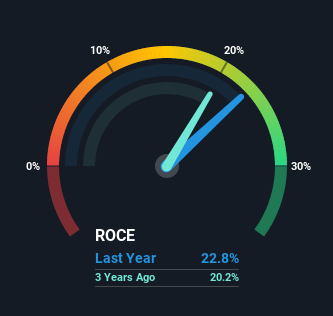Returns On Capital Signal Tricky Times Ahead For Svedbergs i Dalstorp (STO:SVED B)
Finding a business that has the potential to grow substantially is not easy, but it is possible if we look at a few key financial metrics. Firstly, we'd want to identify a growing return on capital employed (ROCE) and then alongside that, an ever-increasing base of capital employed. Put simply, these types of businesses are compounding machines, meaning they are continually reinvesting their earnings at ever-higher rates of return. So while Svedbergs i Dalstorp (STO:SVED B) has a high ROCE right now, lets see what we can decipher from how returns are changing.
Understanding Return On Capital Employed (ROCE)
Just to clarify if you're unsure, ROCE is a metric for evaluating how much pre-tax income (in percentage terms) a company earns on the capital invested in its business. Analysts use this formula to calculate it for Svedbergs i Dalstorp:
Return on Capital Employed = Earnings Before Interest and Tax (EBIT) ÷ (Total Assets - Current Liabilities)
0.23 = kr106m ÷ (kr713m - kr250m) (Based on the trailing twelve months to September 2021).
Thus, Svedbergs i Dalstorp has an ROCE of 23%. That's a fantastic return and not only that, it outpaces the average of 14% earned by companies in a similar industry.
View our latest analysis for Svedbergs i Dalstorp

Above you can see how the current ROCE for Svedbergs i Dalstorp compares to its prior returns on capital, but there's only so much you can tell from the past. If you're interested, you can view the analysts predictions in our free report on analyst forecasts for the company.
So How Is Svedbergs i Dalstorp's ROCE Trending?
On the surface, the trend of ROCE at Svedbergs i Dalstorp doesn't inspire confidence. While it's comforting that the ROCE is high, five years ago it was 35%. Although, given both revenue and the amount of assets employed in the business have increased, it could suggest the company is investing in growth, and the extra capital has led to a short-term reduction in ROCE. If these investments prove successful, this can bode very well for long term stock performance.
What We Can Learn From Svedbergs i Dalstorp's ROCE
While returns have fallen for Svedbergs i Dalstorp in recent times, we're encouraged to see that sales are growing and that the business is reinvesting in its operations. And the stock has done incredibly well with a 119% return over the last five years, so long term investors are no doubt ecstatic with that result. So while investors seem to be recognizing these promising trends, we would look further into this stock to make sure the other metrics justify the positive view.
If you want to continue researching Svedbergs i Dalstorp, you might be interested to know about the 3 warning signs that our analysis has discovered.
Svedbergs i Dalstorp is not the only stock earning high returns. If you'd like to see more, check out our free list of companies earning high returns on equity with solid fundamentals.
New: Manage All Your Stock Portfolios in One Place
We've created the ultimate portfolio companion for stock investors, and it's free.
• Connect an unlimited number of Portfolios and see your total in one currency
• Be alerted to new Warning Signs or Risks via email or mobile
• Track the Fair Value of your stocks
Have feedback on this article? Concerned about the content? Get in touch with us directly. Alternatively, email editorial-team (at) simplywallst.com.
This article by Simply Wall St is general in nature. We provide commentary based on historical data and analyst forecasts only using an unbiased methodology and our articles are not intended to be financial advice. It does not constitute a recommendation to buy or sell any stock, and does not take account of your objectives, or your financial situation. We aim to bring you long-term focused analysis driven by fundamental data. Note that our analysis may not factor in the latest price-sensitive company announcements or qualitative material. Simply Wall St has no position in any stocks mentioned.
About OM:SVED B
Svedbergs Group
Develops, manufactures, and markets bathroom products in the Nordic region, the United Kingdom, and the Netherlands.
Flawless balance sheet with solid track record.
Market Insights
Community Narratives



